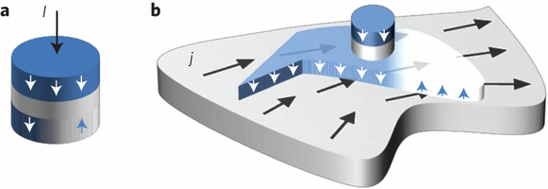R&D: Spin–Orbit Torque Magnetization Switching Controlled by Geometry
For future magnetic storage technology such as MRAM
This is a Press Release edited by StorageNewsletter.com on November 13, 2015 at 3:13 pmNature Nanotechnology has published an article written by C. K. Safeer, Emilie Jué, Alexandre Lopez, Liliana Buda-Prejbeanu, Stéphane Auffret, University of Grenoble Alpes INAC-SPINTEC, Grenoble F-38000, France, and CNRS INAC-SPINTEC, Grenoble F-38000, France, and CEA INAC-SPINTEC, Grenoble F-38000, France, Stefania Pizzini, University of Grenoble Alpes INAC-SPINTEC, Grenoble F-38000, France, and CNRS Institut Néel, 38042 Grenoble, France, Olivier Boulle, Ioan Mihai Miron, and Gilles Gaudin, University of Grenoble Alpes INAC-SPINTEC, Grenoble F-38000, France, and CNRS INAC-SPINTEC, Grenoble F-38000, France, and CEA INAC-SPINTEC, Grenoble F-38000, France.
The geometric specificity of SOT with respect to STT.
a, The pillar shape, characteristic for STT, imposes the same shape on the spin-polarizer (in blue) and the free layer (blue and white). b, The in-plane injection specific to SOT allows the electrically conductive layer (grey) and the m…
Abstract: “Magnetization reversal by an electric current is essential for future magnetic data storage technology, such as magnetic random access memories. Typically, an electric current is injected into a pillar-shaped magnetic element, and switching relies on the transfer of spin momentum from a ferromagnetic reference layer (an approach known as spin–transfer torque). Recently, an alternative technique has emerged that uses spin–orbit torque (SOT) and allows the magnetization to be reversed without a polarizing layer by transferring angular momentum directly from the crystal lattice. With spin–orbit torque, the current is no longer applied perpendicularly, but is in the plane of the magnetic thin film. Therefore, the current flow is no longer restricted to a single direction and can have any orientation within the film plane. Here, we use Kerr microscopy to examine spin–orbit torque-driven domain wall motion in Co/AlOx wires with different shapes and orientations on top of a current-carrying Pt layer. The displacement of the domain walls is found to be highly dependent on the angle between the direction of the current and domain wall motion, and asymmetric and nonlinear with respect to the current polarity. Using these insights, devices are fabricated in which magnetization switching is determined entirely by the geometry of the device.“













 Subscribe to our free daily newsletter
Subscribe to our free daily newsletter
